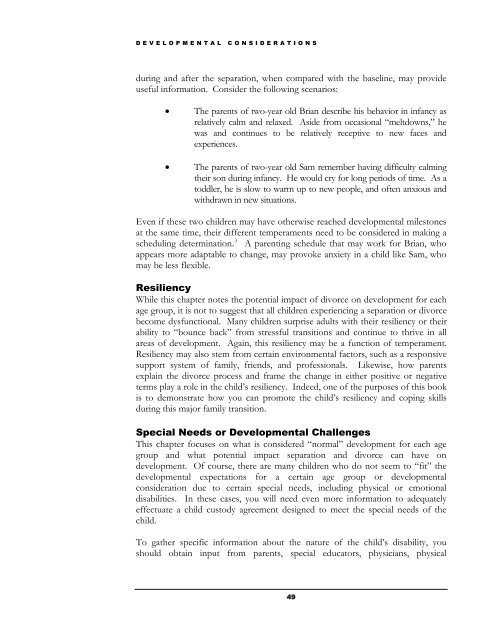A Judge’s Guide
A Judge’s Guide
A Judge’s Guide
You also want an ePaper? Increase the reach of your titles
YUMPU automatically turns print PDFs into web optimized ePapers that Google loves.
DEVELOPMENTAL CONSIDERATIONS<br />
during and after the separation, when compared with the baseline, may provide<br />
useful information. Consider the following scenarios:<br />
The parents of two-year old Brian describe his behavior in infancy as<br />
relatively calm and relaxed. Aside from occasional “meltdowns,” he<br />
was and continues to be relatively receptive to new faces and<br />
experiences.<br />
The parents of two-year old Sam remember having difficulty calming<br />
their son during infancy. He would cry for long periods of time. As a<br />
toddler, he is slow to warm up to new people, and often anxious and<br />
withdrawn in new situations.<br />
Even if these two children may have otherwise reached developmental milestones<br />
at the same time, their different temperaments need to be considered in making a<br />
scheduling determination. 3 A parenting schedule that may work for Brian, who<br />
appears more adaptable to change, may provoke anxiety in a child like Sam, who<br />
may be less flexible.<br />
Resiliency<br />
While this chapter notes the potential impact of divorce on development for each<br />
age group, it is not to suggest that all children experiencing a separation or divorce<br />
become dysfunctional. Many children surprise adults with their resiliency or their<br />
ability to “bounce back” from stressful transitions and continue to thrive in all<br />
areas of development. Again, this resiliency may be a function of temperament.<br />
Resiliency may also stem from certain environmental factors, such as a responsive<br />
support system of family, friends, and professionals. Likewise, how parents<br />
explain the divorce process and frame the change in either positive or negative<br />
terms play a role in the child’s resiliency. Indeed, one of the purposes of this book<br />
is to demonstrate how you can promote the child’s resiliency and coping skills<br />
during this major family transition.<br />
Special Needs or Developmental Challenges<br />
This chapter focuses on what is considered “normal” development for each age<br />
group and what potential impact separation and divorce can have on<br />
development. Of course, there are many children who do not seem to “fit” the<br />
developmental expectations for a certain age group or developmental<br />
consideration due to certain special needs, including physical or emotional<br />
disabilities. In these cases, you will need even more information to adequately<br />
effectuate a child custody agreement designed to meet the special needs of the<br />
child.<br />
To gather specific information about the nature of the child’s disability, you<br />
should obtain input from parents, special educators, physicians, physical<br />
49


